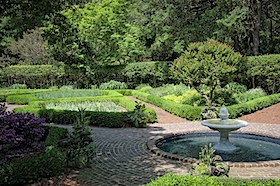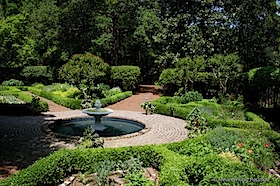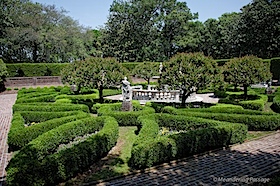There’s a great deal of history behind the design and style of formal English Gardens.
“The earliest English gardens that we know of were planted by the Roman conquerors of Britain in the 1st century AD…
…It was not until the Middle Ages that gardens once more became important in British life…
…As castles gave way to fortified manor houses in the later medieval period, the garden became a simple green space surrounded by hedges or fences…
…The next stage of the English garden came after the Reformation. Many landowners enclosed common land to create parks for keeping deer or cattle. This ‘natural’ landscape gave way to formal gardens near the house, still sheltered from the outside world by hedges or walls…
…The Tudors followed Italian influence in creating gardens which mirrored the alignment of the house, creating a harmony of line and proportion that had been missing in the Medieval period. For the first time since the Romans left, sundials and statues were once more popular garden ornaments…
…The 18th century saw a swing from Renaissance formality to a more “natural” look…
…Lines were no longer straight, paths curve and wander, and parterres are replaced by grass. Trees were planted in clusters rather than in straight lines, and rounded lakes replaced the rectangular ponds of the earlier style. The garden became open, a park joining the house to the outside world rather than a carefully nurtured refuge from it…
…In the Victorian era the pendulum swung again, to massed beds of flowers (bedding out plants raised in greenhouses), exotic colours, and intricate designs…”
— English Gardens, Britain Express
Passing through the welcome center at The Elizabethan Gardens you come upon formal English gardens. The top two images are made immediately behind the Welcome Center — this greenery is viewable in the previously posted Welcome Center window. The bottom left is from the Sunken Garden located further along the paths and the bottom right image is a viewing arch for the Sunken Garden carved into the surrounding hedge.
There are also forest sections with beautiful winding paths and benches in The Elizabethan Gardens we’ll explore next. One of these paths holds court to a living piece of history.
Discover more from Meandering Passage
Subscribe to get the latest posts sent to your email.





I like the collection of shots showing this beautiful, formal garden. Keeping all those rows trimmed but be a full-time job for someone. Nice post.
Don, you’re right that would be a full-time job and they do have several full time employees to tend to the gardens. Then there’s also some volunteers.
I am already looking forward to the next chapter. What a terrific cliff hanger. Rather like those old serials at the movies. I am glad you included the highly informative segment from Britain Press. But, most impotant of all, your photos do a superb job of bringing that text to life. I must say, from my view up here in the mountains with the desert below so near, the sight of all that lush greenery makes my heart go pitty-pat.
Anita, I think the next chapter will probably be the final one for this series.
I didn’t wasn’t fully aware there was such a rich history behind the design of these English Gardens until I did a little research for this post, so I thought I’d share some of my enlightenment by including the Britain Press segment.
Thanks!
While I can only putter around in my back yard trying to get things to grow, I can appreciate the design and the skill necessary to achieve something as grand as this. While they look so peaceful, there is an extraordinary amount of effort to plan something like this and keep it thriving.
While I enjoy this I don’t harbor any illusions about being able to design or create something like this either. For certain, it’s a lot of work.
Interesting tid-bits on gardens that I did not know. When I see these gardens I wonder what it would have been like to have enough property to put one of them in and how much time is required to maintain on.
Monte, I do know that these gardens have at least a couple of full time horticulturist employed. I can only imagine the amount of work. Then they also do special lighting at Christmas….
Quite interesting that these can be traced back to the Romans!
Mark, I didn’t know the Romans were perhaps the initiators of these garden concepts either. I’ve learned a lots doing research for the posts and photos here.